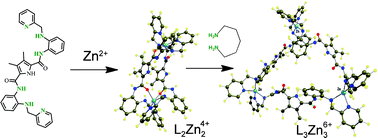Control of metal-directed self-assembly by metal–amine interactions†
Abstract
The complexation of a tweezers

* Corresponding authors
a
Institut für Organische Chemie, Universität Regensburg, Universitätsstr. 31, Regensburg, Germany
E-mail:
evgeny.katayev@chemie.uni-r.de
Tel: 49 941 9434628
The complexation of a tweezers

 Please wait while we load your content...
Something went wrong. Try again?
Please wait while we load your content...
Something went wrong. Try again?
E. A. Katayev and M. B. Schmid, Dalton Trans., 2011, 40, 2778 DOI: 10.1039/C0DT01056A
To request permission to reproduce material from this article, please go to the Copyright Clearance Center request page.
If you are an author contributing to an RSC publication, you do not need to request permission provided correct acknowledgement is given.
If you are the author of this article, you do not need to request permission to reproduce figures and diagrams provided correct acknowledgement is given. If you want to reproduce the whole article in a third-party publication (excluding your thesis/dissertation for which permission is not required) please go to the Copyright Clearance Center request page.
Read more about how to correctly acknowledge RSC content.
 Fetching data from CrossRef.
Fetching data from CrossRef.
This may take some time to load.
Loading related content
